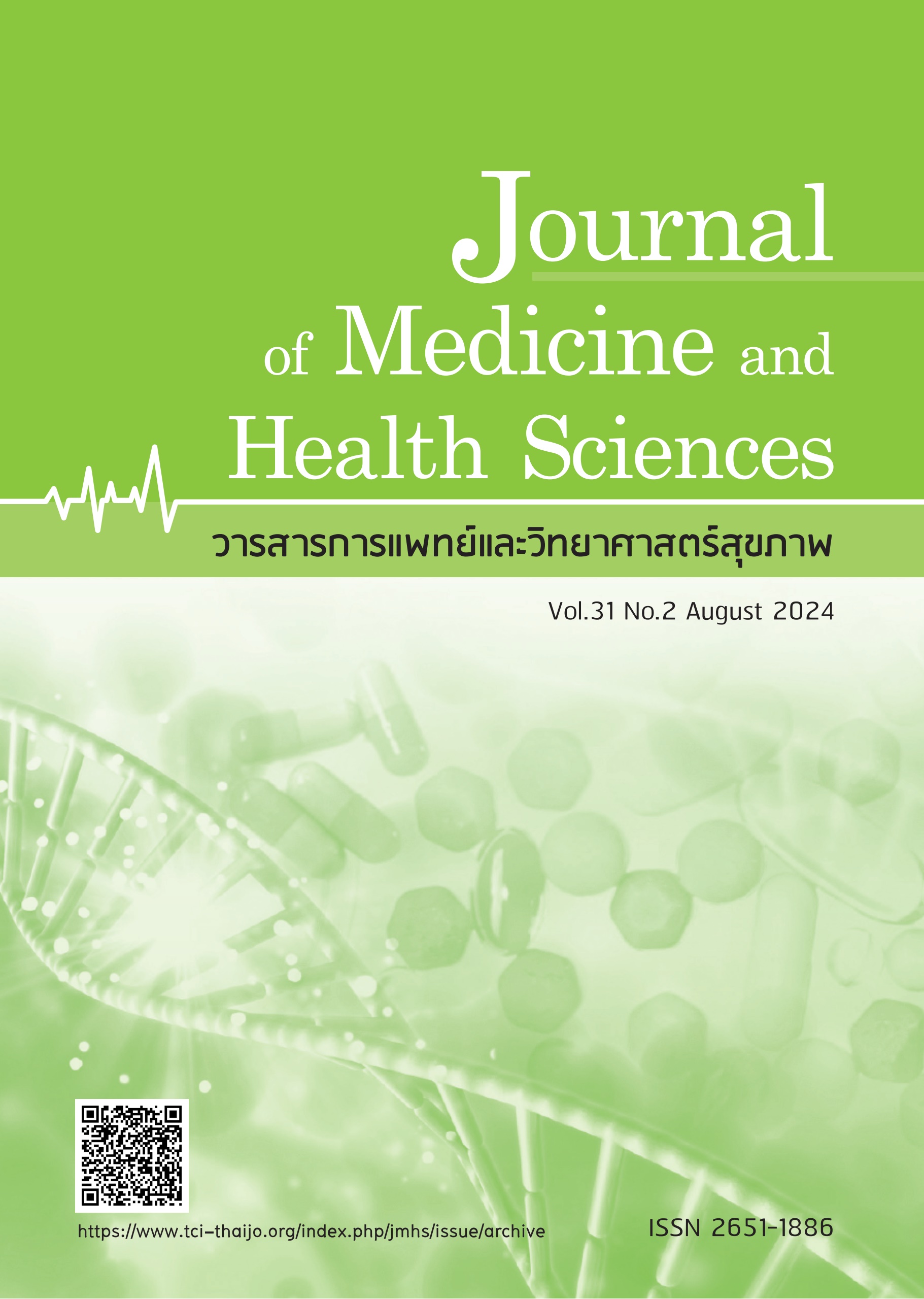ผลของนวัตกรรมกายภาพต่อการฟื้นสภาพด้านการเคลื่อนไหวและการทำงานของรยางค์ส่วนบน: การศึกษานำร่องในผู้ป่วยโรคหลอดเลือดสมอง
คำสำคัญ:
โรคหลอดเลือดสมอง, การฟื้นฟูสมรรถภาพ, นวัตกรรม, Fugl-Meyer Assessment, Action research arm testบทคัดย่อ
วัตถุประสงค์ของการวิจัยเพื่อศึกษาผลของนวัตกรรมกายภาพต่อการฟื้นสภาพด้านการเคลื่อนไหวและการทำงานของรยางค์ส่วนบนในผู้ป่วยโรคหลอดเลือดสมองที่แผนกเวชศาสตร์ฟื้นฟู ศูนย์การแพทย์สมเด็จพระเทพรัตนราชสุดา ฯ สยามบรมราชกุมารี โดยเป็นการวิจัยแบบศึกษากลุ่มเดียววัดสองครั้ง (The One-Group Pretest-Posttest Design) และใช้วิธีการเลือกกลุ่มตัวอย่างแบบเจาะจง (purposive sampling) โดยใช้วิธีการเลือกกลุ่มตัวอย่างตามเกณฑ์การคัดเข้าและทำการสุ่มตัวอย่างแบบเจาะจง (Simple random sampling) มาฟื้นฟูสภาพด้านการเคลื่อนไหวและการทำงานของรยางค์ส่วนบนโดยใช้นวัตกรรมเพื่อการฟื้นฟูสมรรถภาพรยางค์ส่วนบนในผู้สูงอายุและผู้ป่วยโรคหลอดเลือดสมองของนิตอลินทร์และคณะ[12] ใช้เวลาฝึกครั้งละ 1 ชั่วโมง จำนวน 3 ครั้งต่อสัปดาห์ ติดต่อกัน 4 สัปดาห์ ผลการวิจัยพบว่า ผู้ป่วย 10 คน เพศชาย 6 คนเป็นเพศหญิง 4 คน อายุเฉลี่ย 61.80±16.50 ปี ระยะเวลาการเป็นโรคหลอดเลือดสมองเฉลีย 4.9±1.728 เดือน ผลการเปรียบเทียบข้อมูลก่อนและหลังการใช้นวัตกรรมเพื่อการฟื้นฟูสมรรถภาพรยางค์ส่วนบนในผู้สูงอายุและผู้ป่วยโรคหลอดเลือดสมองร่วมกับการฟื้นฟูสมรรถภาพแบบดั้งเดิมพบว่า ระดับคะแนน Fugl-Meyer Assessment สำหรับการประเมินความสามารถในการควบคุมการเคลื่อนไหวของรยางค์ส่วนบน โดยก่อนการใช้นวัตกรรม มีค่าเฉลี่ยของคะแนนและส่วนเบี่ยงเบนมาตรฐานเท่ากับ 79±16.181 และหลังการใช้นวัตกรรม มีีค่าเฉลี่ยของคะแนนและส่วนเบี่ยงเบนมาตรฐานเท่ากับ 98.50± 15.582 ซึ่งมีการเพิ่มขึ้นอย่างมีนัยสำคัญทางสถิติที่ p<0.05 เช่นเดียวกันกับ Action research arm test พบว่าก่อนการใช้นวัตกรรม มีค่าเฉลี่ยของคะแนนและส่วนเบี่ยงเบนมาตรฐานเท่ากับ 17.30±16.310 และหลังการใช้นวัตกรรม มีีค่าเฉลี่ยของคะแนนและส่วนเบี่ยงเบนมาตรฐานเท่ากับ 25.20±19.759 ซึ่งมีการเพิ่มขึ้นอย่างมีนัยสำคัญทางสถิติที่ p<0.05 ค่ากำลังของกล้ามเนื้อแขนและมือส่วนต้นโดยมีค่าเฉลี่ยส่วนเบี่ยงเบนมาตรฐานก่อนใช้นวัตกรรมเท่ากับ 8.00±2.867 และหลังการใช้นวัตกรรมเท่ากับ 9.8±3.615 และค่ากำลังของกล้ามเนื้อมือส่วนปลายมีค่าเฉลี่ยส่วนเบี่ยงเบนมาตรฐานก่อนใช้นวัตกรรมเท่ากับ 5.60±3.950 และหลังการใช้นวัตกรรมเท่ากับ 7.40±4.789 และค่าองศาของการเคลื่อนที่ของข้อต่อ พบว่าข้อต่อมีองศาของการเคลื่อนไหวเพิ่มขึ้นอย่างมีนัยสำคัญทางสถิติ ที่ p<0.05 ทั้งการงอและการกางข้อไหล่และการงอข้อศอกซึ่งสนับสนุนว่านวัตกรรมต่อการฟื้นสภาพด้านการเคลื่อนไหวและการทำงานของรยางค์ส่วนบนนี้มีประโยชน์ต่อผู้ป่วยโรคหลอดเลือดสมอง
เอกสารอ้างอิง
Feigin VL, Brainin M, Norrving B, et al. World Stroke Organization (WSO): Global stroke fact sheet. Int J Stroke. 2022;17(1):18-29.
Tiamkao S. Incidence of stroke in Thailand. Thai J Neurology. 2023;39(2):39-46.
Pajareya K, editor. Rehabilitation of stroke patients. Bangkok: Medical Education Technology Center, Faculty of Medicine Siriraj Hospital, Mahidol University; 2003.
Rattanachaiyanont M, Tantawichien T, Chierakul N, et al. Contemporary medicine: Medical science advances in harmony to improve the quality of life. 2nd ed. Bangkok: P.A. Living; 2009.
Housman SJ, Scott KM, Reinkensmeyer DJ. A randomized controlled trial of gravity-supported, computer-enhanced arm exercise for individuals with severe hemiparesis. Neurorehabil Neural Repair. 2009;23(5):505-14. Epub 2009 Feb 23.
Péter O, Fazekas G, Zsiga K, et al. Robot-mediated upper limb physiotherapy: review and recommendations for future clinical trials. Int J Rehabil Res. 2011;34(3):196-202.
Colomer C, Baldoví A, Torromé S, et al. Efficacy of Armeo® Spring during the chronic phase of stroke. Study in mild to moderate cases of hemiparesis. Neurologia. 2013;28(5):261-7. Epub 2012 Jun 23.
Keeling AB, Piitz M, Semrau JA, et al. Robot enhanced stroke therapy optimizes rehabilitation: a pilot study. J Neuroeng Rehabil. 2021;18(1):10.
Dehem S, Gilliaux M, Stoquart G, et al. Effectiveness of upper-limb robotic-assisted therapy in the early rehabilitation phase after stroke: a single-blind, randomised, controlled trial. Ann Phys Rehabil Med. 2019;62(5):313-20. Epub 2019 Apr 24.
Patel J, Fluet G, Qiu Q, et al. Intensive virtual reality and robotic based upper limb training compared to usual care and associated cortical reorganization in the acute and early sub-acute periods post-stroke: a feasibility study. J Neuroeng Rehabil. 2019;16(1):92.
Carpinella I, Lencioni T, Bowman T, et al. Effects of robot therapy on upper body kinematics and arm function in persons post stroke: a pilot randomized controlled trial. J Neuroeng Rehabil. 2020;17(1):10.
Phunapai N, Aramrussameekul W, Limboonruang T, et al. Research and development of innovations to rehabilitate arm functionality in elderly individuals and stroke patients with muscle weakness. SWU.JST [Internet]. 2024 Apr 30 [cited 2024 Aug 29];16(31):1-16, Article 254057. Available from: https://ph02.tci-thaijo.org/index.php/swujournal/article/view/254057
Gladstone DJ, Danells CJ, Black SE. The fugl-meyer assessment of motor recovery after stroke: a critical review of its measurement properties. Neurorehabil Neural Repair. 2002;16(3):232-40.
Yozbatiran N, Der-Yeghiaian L, Cramer SC. A standardized approach to performing the action research arm test. Neurorehabil Neural Repair. 2008;22(1):78-90. Epub 2007 Aug 17.
Singh N, Saini M, Kumar N, et al. Evidence of neuroplasticity with robotic hand exoskeleton for post-stroke rehabilitation: a randomized controlled trial. J Neuroeng Rehabil. 2021;18(1):76.
Sale P, Franceschini M, Mazzoleni S, et al. Effects of upper limb robot-assisted therapy on motor recovery in subacute stroke patients. J Neuroeng Rehabil. 2014;11:104.
ดาวน์โหลด
เผยแพร่แล้ว
รูปแบบการอ้างอิง
ฉบับ
ประเภทบทความ
สัญญาอนุญาต
ลิขสิทธิ์ (c) 2024 วารสารการแพทย์และวิทยาศาสตร์สุขภาพ

อนุญาตภายใต้เงื่อนไข Creative Commons Attribution-NonCommercial-NoDerivatives 4.0 International License.



